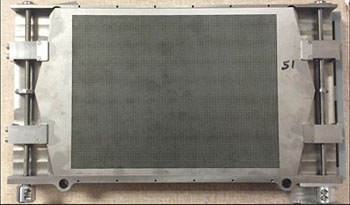Innovative Collimator Improves Breast Screening with Less Radiation
By MedImaging International staff writers
Posted on 28 Jun 2016
Adding a variable angle slant hole (VASH) collimator to an existing breast molecular imaging system provides better contrast of cancer lesions while potentially reducing radiation doses by half, according to a new study.Posted on 28 Jun 2016
Developed by researchers at the Thomas Jefferson National Accelerator Facility (JLab; Newport, VA, USA), Dilon Technologies (Newport, VA, USA) and the University of Florida (UF, Gainesville, USA), the new VASH collimator is constructed from a stack of 49 tungsten sheets, each one a quarter of a millimeter thick containing an identical array of square holes. The sheets are stacked like a deck of cards, with angled edges on two sides; the angle of the array in the stack can be slanted by two small motors that slide the individual sheets. The result is a systematic varying of the focusing angle of the collimator during the imaging procedure.

Image: The VASH collimator (Photo courtesy of JLab).
In a study to test the system, the researchers evaluated the spatial resolution and contrast-to-noise ratio in breast phantom of a breast, with four beads inside that simulated cancer tumors of varying diameter and marked with a radiotracer. They found that when using the VASH collimator with an existing breast molecular imaging system, they got an image with six times better contrast, which could potentially reduce the radiation dose by half, while maintaining the same or better image quality. The test results were presented at the Society of Nuclear Medicine and Molecular Imaging annual meeting, held during June 2016 in San Diego (CA, USA).
“While a mammogram uses X-rays to show the structure of breast tissue, molecular breast imagers show tissue function. A radiotracer attached to the molecule gives off gamma rays, which can be picked up by the molecular breast imager,” said Drew Weisenberger, PhD, leader of the JLab radiation detector and imaging group. “Now, you can get a whole range of angles of projections of the breast without moving the breast or moving the imager. You're able to come in real close, you're able to compress the breast, and you can get a one-to-one comparison to a 3D mammogram.”
Mammography is the gold standard of breast cancer screening; but about half of all women who follow standard screening protocol for 10 years will receive a false-positive result that will require additional screening. Used in conjunction with mammography, imaging based on nuclear medicine is a successful secondary screening technique to reduce the number of false positive results in women with dense breasts and at higher risk for developing breast cancer.
Related Links:
Thomas Jefferson National Accelerator Facility
Dilon Technologies
University of Florida














